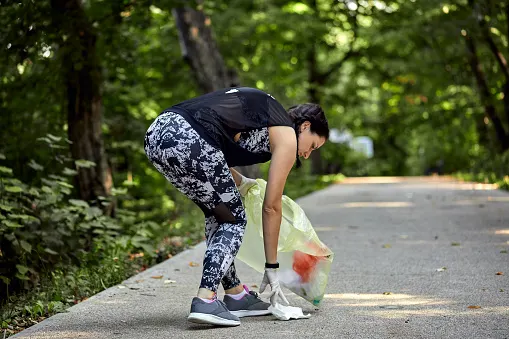
Simple way to boost your health while helping the environment
Want to be environmentally friendly and get fit at the same time? Try plogging!
With winter around the corner, you may want to take advantage of the current weather conditions by spending a little more time outdoors.
Well, if you do so, you may want to consider taking part in plogging. It may sound like a complicated activity to learn, but it’s actually quite simple – you jog while picking up trash in your surroundings. All that is needed is a trash bag, your desire to clean up and a little exercise to stop, bend down and grab the garbage off the ground.
Essentially, you can plog and plalk (pick up litter while you walk) anywhere you find trash on the ground.
SEE ALSO: Upcycling reduces Canada's waste by giving leftovers a second life
Plogging began as a fad in Sweden in 2016 and then made its way into our lands sometime in 2018. It was originally established as an organized group activity to reduce plastic pollution, but is now widely accepted as a healthy workout, too.
The word paints a perfect picture of the action, as it combines jogging and the Swedish word plocka upp, or pick up. Plalking is doing the same thing except you’re walking while picking up garbage.
PLOGGING IN CANADA
Dano Fuller, a fitness trainer from Stratford, Ont., launched Plogging Canada on Facebook as a way to connect users of the physical activity from across Canada. People are using the forum to post photos of their trash hauls from their workouts and cleanups and to talk to others about their experiences.
Because he is passionate about fitness and the environment, plogging just “stuck to me. I took it and ran with it and I enjoy it,” Fuller told The Weather Network in 2019.
“I thought it was a really cool idea. I’ve always been kind of somewhat environmentally safe. I love to train and coach soccer, so I thought plogging and getting out and doing fitness stuff would be a great way to add a little more fun into picking up litter,” said Fuller.
He said a particularly “crucial” time to start plogging is in the spring, since many public areas get congested with trash during the winter months and you really notice it once the snow melts.
If plogging is done regularly, the fitness trainer says it could be particularly effective in reducing litter around and in lakes, rivers and oceans, noting the annual efforts of The Great Canadian Shoreline Cleanup as an example of how beneficial trash pickup is.
“(Plastic) getting into the oceans is a big problem and polluting the wildlife within the oceans and seas. Plastic doesn’t break down. It’s one of the biggest issues environmentally. The cleanup is essential,” said Fuller.
Because of Sweden’s environmental reputation, Fuller said he isn’t surprised this concept went viral there and has been well-received in Canada, too.
“The more people we can get doing it and showing our kids growing up to treat the environment a little better…it’s a win-win situation," he added.
HEALTH BENEFITS ARE PLENTIFUL, TOO
While describing plogging, Raechel Bonomo of Nature Conservancy of Canada, said bending down to pick up litter can work your glutes, abs and arms, as well as your “already-fired-up” leg muscles from running. By going back and forth from running, which increases your heart rate, to stopping to pick up the trash and slowing down your heart rate, you’re performing a form of high-intensity interval training (HIIT).
“HIIT is considered to be an effective workout for improving your overall health, including benefits such as increasing your metabolism and strengthening your heart,” Bonomo wrote in the post.

Plogging and plalking can be enjoyed alone or with friends. Photo: Getty Images
She cautions people plogging should be done with caution, like any type of exercise, and advises those participating to keep an eye out for hazards and debris along their routes. Bonomo also recommends people wear gloves when picking up trash.
TRENDS GO COUNTRYWIDE
The Great Canadian Shoreline Cleanupis a national conservation initiative that helps people tackle pollution through cleanups along lakeshores and waterways. Since 1994, there have been 27,800 cleanups that have collected more than two million kilograms of trash across Canada’s shorelines.
READ MORE: How plastics harm wildlife
The group hosted a few of its own plogs in 2018, including one in partnership with United Nations to celebrate World Environment Day, as well as provided support to numerous volunteers using plogging in their own efforts.
The plogging/plalking workout, which has been used to improve parks across the world, has also been garnering attention on social media. Ploggers have posted photos and shared their experiences on Twitter and Instagram using the #plogging, #plalking and #trashtag hashtags.
“Thanks to social media, not only are ploggers connecting and inspiring one another on an international level, they are coming together nationally and locally to encourage one another to help keep the natural areas in their communities free from litter,” said Bonomo.
Thumbnail courtesy of Getty Images.
VIDEO: ON THE FRONT LINES RESCUING MARINE ANIMALS FROM OCEAN PLASTIC
Find Nathan Howes on Twitter.











